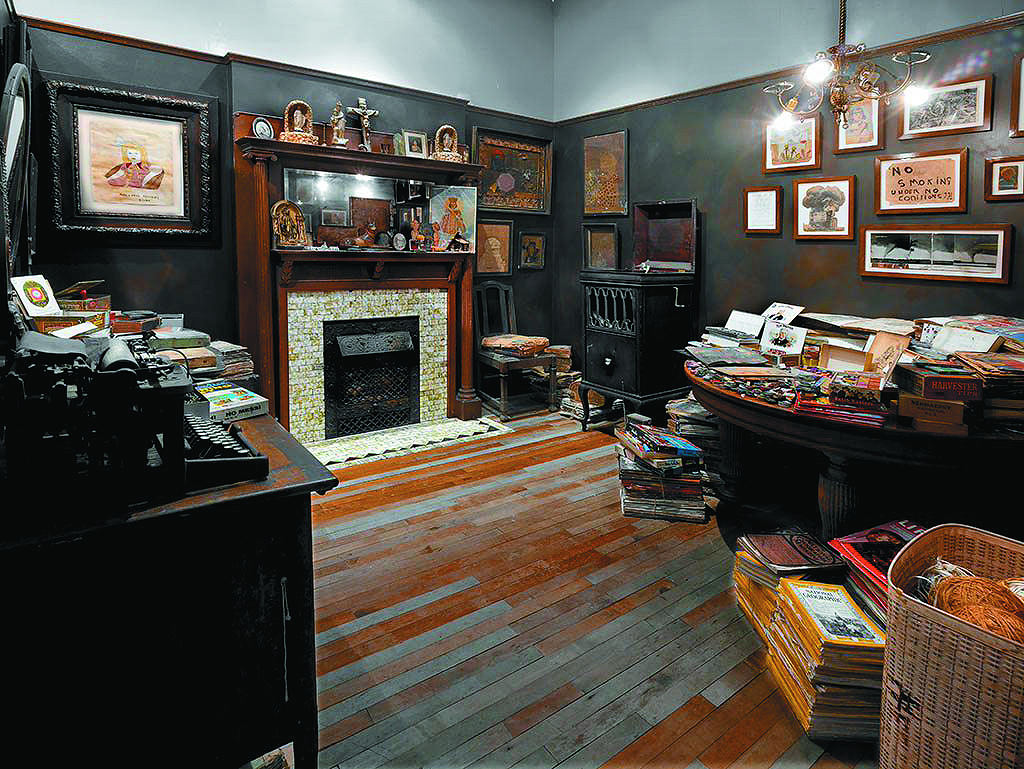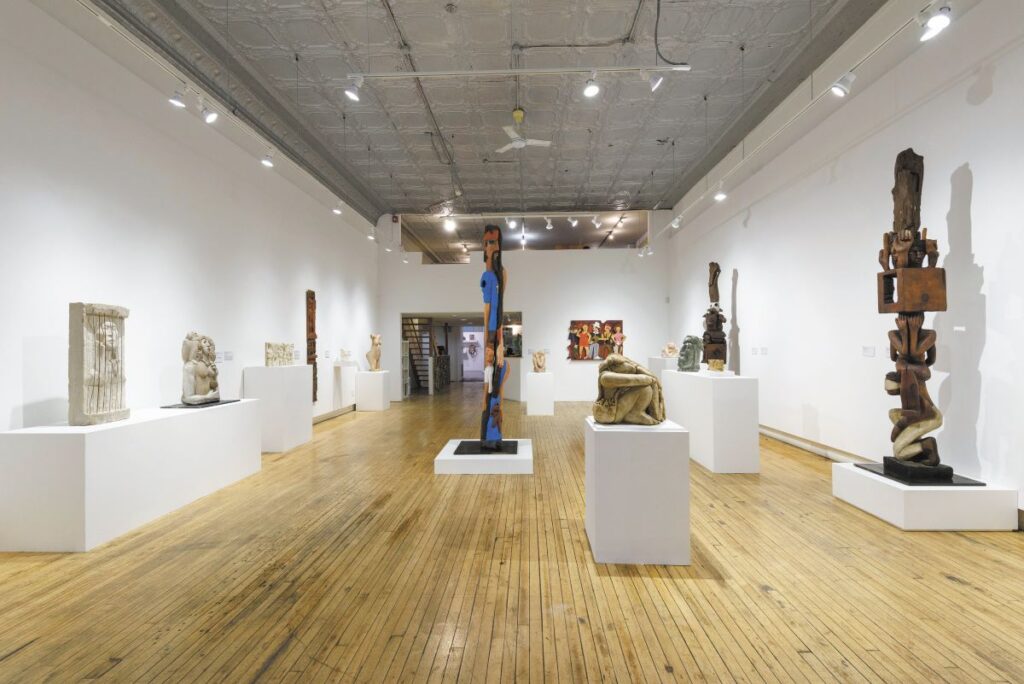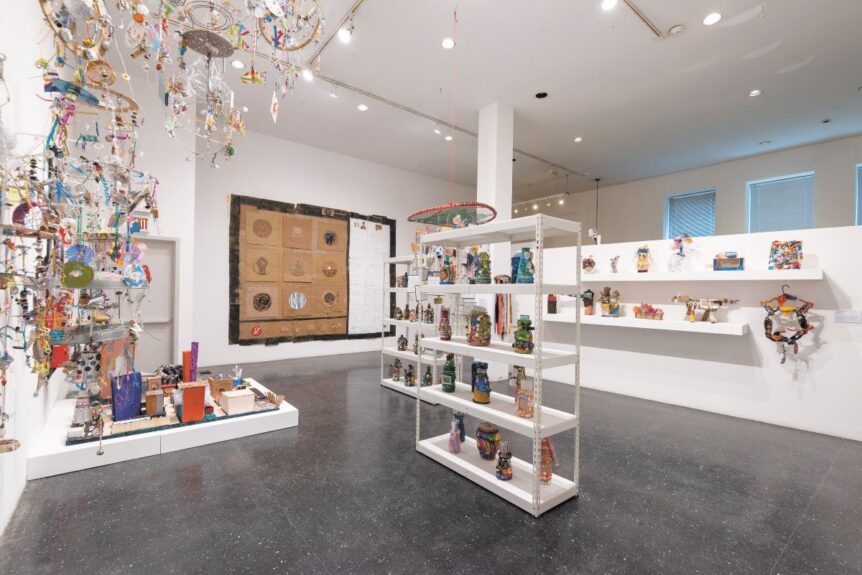
In 1941, the Arts Club of Chicago gave a show to self-taught, Pennsylvania-born artist Horace Pippin, a disabled World War I vet whose work had been included in the 1938 exhibition Masters of Popular Painting at New York’s Museum of Modern Art. A decade later, the club’s members invited the iconoclastic French artist Jean Dubuffet to speak, and listened to him urge the embrace of “instinct, passion, caprice, violence, madness” in art-making. In the ’50s and ’60s, educators and artists at the School of the Art Institute of Chicago—including Kathleen Blackshear, Whitney Halstead, Ray Yoshida—urged students to look beyond the mainstream as they developed their notions of art. In the 1970s Chicago art dealer Phyllis Kind pioneered the market in outsider art, showing the work of locals Henry Darger and Joseph Yoakum, among others. By 1979 Chicagoans had fostered the emergence of what Dubuffet called art brut to such an extent that the city’s Museum of Contemporary Art was able to present an exhibition, Outsider Art in Chicago, comprised entirely of work by area artists.

The centrality of outsider work in Chicago was made tangible in 1991, when art collectors Susann Craig and Scott Lang, along with dealer Carl Hammer and others, founded the Society for Outsider, Intuitive, and Visionary Art—now known as Intuit: The Center for Intuitive and Outside Art. Since 1999 Intuit has operated from a 150-year-old, red brick building on North Milwaukee Avenue. Welcoming some ten thousand visitors annually (by a pre-Covid-19 count), and with an operating budget of approximately $1 million, Intuit is no behemoth. Yet as one of the few museums in the country dedicated solely to self-taught and outsider art—and boasting robust online programming—it enjoys a national profile among curators, collectors, and critics. As the recent recipient of a $5 million development grant from the city of Chicago, Intuit hopes to increase its appeal to the public by undergoing a significant enhancement of its facility.
Intuit’s renovation program will double exhibition space; create a dedicated education area and art-making studio; and re-envision its Henry Darger Room, an installation featuring contents from the tiny apartment where the Chicago janitor created his famed fantasy epic of violence and curious sexuality, fashioned from cartoons, advertisements, coloring books, and other ephemera. In addition, the renovation—conceived by the Chicago architectural firm Doyle and Associates—will provide Intuit a friendlier new street facade. “I think that will be the most transformational piece of all,” says Intuit’s president and CEO, Debra Kerr. “The current facade is rather forbidding. People even struggle to find the door.”
Intuit’s permanent collection is composed of approximately thirteen hundred works, all of which were donated. Artists represented include William Dawson, Minnie Evans, Howard Finster, Lee Godie, Mr. Imagination, Michel Nedjar, Wesley Willis, and Yoakum. “Until now, we haven’t been able to afford (nor have we really needed) an acquisitions budget,” says Kerr, “but our Young Professionals Board has embarked on an acquisitions project and will be visiting galleries and artists’ studios.”



In recent seasons, Intuit has presented the biographically driven assemblages, portraits, and landscapes of Chicagoan Marvin Tate; the poetry-infused drawings of Philadelphia artist Justin Duerr; and the work of Kentucky-born George Widener, a math whiz fascinated by calendars and numbers. Intuit closed for renovations after Labor Day, and plans to re-open sometime in the summer of 2024 with a show focusing on artists who began their artistic practice after immigrating to Chicago, such as Derek Webster, who came from Belize, and Drossos Skyllas, a Greek-born painter whose work was discovered by dealer Phyllis Kind after his death. “We’ll be asking what made them turn to art,” says Kerr. “Was it homesickness, exposure to other artists—what were the circumstance that allowed them to be creative?”
Kerr is especially keen to ramp up opportunities for artists and the public to meet. Last year, in tandem with the exhibition Roman Villarreal: South Chicago Legacies, Intuit offered a workshop conducted by the artist, a former steel mill worker. “There’s something special that happens when we have a living artist here,” says Kerr. “There’s a program in Illinois designed to obtain release for seniors serving time for armed robberies in which no one was harmed, so that they can finish up their lives in meaningful ways. One of those is an amazing artist, Arkee Chaney, who came to art-making while in prison. He participated in a virtual talk and was very open about his experience. The young people who heard him were especially impressed. Here was someone who had difficulties, had barriers to overcome, whose experience was relevant to their lives.”
If there is one lesson that Intuit and the artists whose work is presented there can impart, it is this: that the will to creative expression can defeat any impediment.

